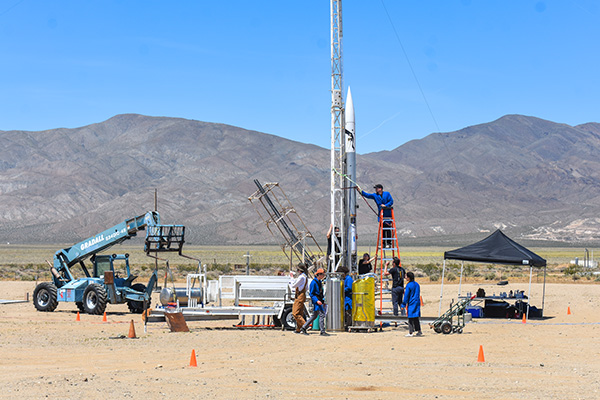UCI Students Launch Cutting-Edge Methalox Rocket

June 22, 2023 - Methane – the propellant that can be produced on Mars - has been called “the fuel of the future.” That’s why Space X, Relativity Space and others are racing to see who can send a rocket into orbit using it.
The UCI Rocket Project, a team of engineering undergraduate students, challenged themselves by taking on methalox, the progressive propellant made of methane and oxygen, rather than using a more traditional fuel such as kerosene. “We wanted to expose ourselves to the future of propulsion,” said Operations Lead Kyle Deck, “and the blue flame looks a lot cooler.”
On April 29, they became one of the first undergraduate rocket teams to design and launch a "methalox" rocket, which uses liquid natural gas (LNG) composed primarily of methane as the fuel and liquid oxygen (LOX) as the oxidizer. Their 20-foot bipropellant rocket traveled 9,300 feet above ground level with over 13 seconds of burn time.

That successful launch was a culmination of nearly six years, including delays due to the pandemic, of engineering by hundreds of students. “Seeing it go up was our biggest dream this year,” said Chief Engineer Nitish Chennoju, a senior computer science engineering major.
Methalox has become the choice propellant for cutting-edge companies because it’s made of a simple hydrocarbon - methane - that can be synthesized on Mars. These rockets being designed to travel to the Red Planet could thus take a pit stop on Mars to make the fuel they need to travel back.
Their bipropellant rocket used LNG and LOX, which are difficult and dangerous to work with. “There are so many systems that can go wrong,” said Liquids Team Project Manager Sky Hargrove. LOX is extremely flammable so the students could only test in the desert. If there was a leak, which they fortunately did not experience, they would have to stop immediately.
LNG and LOX are both cryogenic, liquifying at temperatures as low as -183 Celsius, so it’s difficult to get accurate propellant weights. Many valves aren’t rated for cryogenic liquids, so the students had to modify and test their own valves on campus.
“It was pretty amazing, the experience you can get as a student - being able to build, test and launch a rocket. You apply different equations you’ve learned on the fly,” said Hargrove, a senior mechanical engineering major. “These experiences are pretty compatible to industry.”

The students built and tested the rocket on their own, with consultations from their project adviser Xian Shi, assistant professor of mechanical and aerospace engineering, and the occasional call out to industry experts. Their tests were done on Friends of Amateur Rocketry sites.
Most of the rocket parts and systems were designed by students. This includes the High Pressure Quick Disconnect system, which hooks up to the 6,000 psi tank of nitrogen that goes through the plumbing and then disconnects remotely. The highly volatile system pressurizes up to 6,000 pounds per square inch and was perfected by Hargrove's team through a senior design project.
Propulsion Lead Brian Devine, an aerospace engineering major, led the design of the main valve actuation system, which controls the valves remotely, so students don’t have to be near the rocket when it’s firing.
Launch Vehicle Lead Alek Parolari-Grosgurin led a team that created the fins out of reinforced carbon fiber using complex calculations to get just the right dimensions to direct the flight. It was smooth flying as the fins guided the rocket on its journey and returned in excellent shape.
The engine was also designed by the students, though they outsourced the welding. Hargrove said getting enough ablative cooling so the fire wouldn’t burn the engine when it came through was the main challenge they had to overcome.
One of next year’s goal is improved recovery. Most of this year’s components are reusable but there were some damages to parts during the launch. “If you’re able to recover, you can launch again in the same day,” said Hargrove. “Reusability is an issue that’s big in industry too.”

The UCI Rocket Project Liquids Team aims to launch even more methalox rockets. Their recent success inspired 200 students to apply for next year’s team. A second round of applications will begin in August.
The project is largely supported by donors, and Northrop Grumman and Blue Origin contributed generously to the nearly $50,000 needed for the tests, materials and launch of this rocket. They will need more funding to build and launch a new one next year.
With the success of their methalox rocket, many team members aspire to send one into interstellar space as professional rocket scientists. “Our students have shown remarkable teamwork, ingenuity and a true passion for rocket science and engineering,” Shi said. “I have no doubt that this is only the beginning of their bright futures filled with countless more innovative and inspiring achievements."
- Natalie Tso

